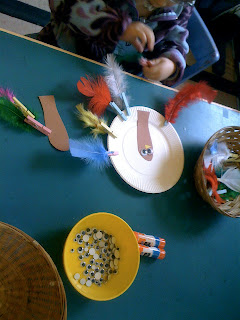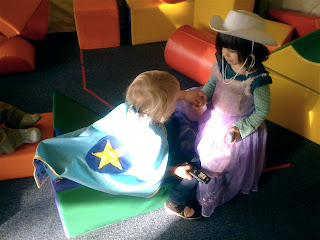I think the world is becoming a better place, in part, because of the renewed interest in crafting. It's a branch of the do-it-yourself mentality that can ultimately, if those of us who understand the power (and joy) in this movement continue to role-model and recruit, help wrest control of our economic lives back from giant corporations. I know, I know, most of you don't see crafting as a political act, but it is. Every time we do or make something that we could have purchased, or better yet, every time we teach a child to do or make something instead of buying it, we all gain a little more control of our own lives.
For most of the kids, applying those eyes was a bigger
fine motor challenge than adding the feathers.
So, you know, I don't mean any disrespect to crafters when I say that we rarely undertake craft projects at Woodland Park, for which I provided my own definition in a previous post:
More rarely, we engage in the "crafts," which I define as an activity at the art table with the goal of manufacturing a pre-determined object. You can usually tell it's a craft when the art parent feels compelled to announce, "Today we're making spiders," or "Everyone's making flowers," as children approach. Craft projects also tend to be those that require a lot of adult intervention to produce the objective, especially when working with 2-3 year olds. More often than not our craft projects are chosen because they encourage children to explore certain classroom skills (e.g., cutting on a straight/curved line, operating a stapler/hole punch) or work on fine motor skills (e.g., using brads, lacing), with the "art" being a motivator.
Not only do we rarely engage in crafts, but we've also never done any kind of Thanksgiving-related activity other than to share, after the fact, what we did, who we got to see, and what parts of the meal we did and didn't like. But when I saw the brilliant Pink and Green Mama MaryLea's Clothespin Turkey Fine Motor Practice post, I was inspired to turn it into a craft by way of extending the clothespin practice we'd already had in building The Den Experiment during the prior couple weeks. The fact that it was Thanksgiving-related was just an added bonus.
It's interesting that most of the kids arranged their feathers
off to one side, rather than around the top as I'd expected.
On the weekend I swung by Daiso, the Japanese version of the dollar store (although everything there is $1.50), and found miniature clothes pins, then got into school early on the Monday before our Thanksgiving break to manufacture 150 clothespin feathers using my handy-dandy glue gun. It was about the time I'd completed this task that it became clear that school was going to get snowed out. In fact, we were snowed out for the rest of the week, leaving me with an actual Thanksgiving craft on my hands and no little hands to undertake it.
Ava got to the project a little late in the morning. Knowing this
she told me that I'd have to wait to beat the drum for clean-up
time until she was finished, which I did.
So this is all just a long-winded way of explaining why the Woodland Park kids have extended our celebration of the holiday into this week.
Isak was very proud of his turkey and really wanted to make sure I got a
picture, although either he or I couldn't stay still long enough to get a
non-blurry shot.





















































